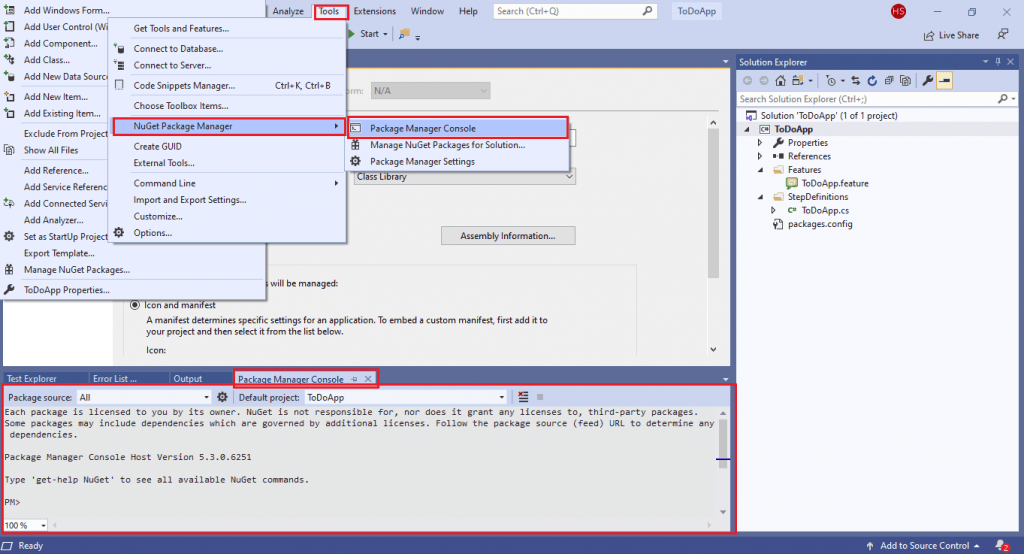
- Visual studio package manager console commands install#
- Visual studio package manager console commands update#
- Visual studio package manager console commands code#
Visual studio package manager console commands update#
In particular, update could work well in the constrained scenario where the new version on the package just updates an assembly but doesn’t do much else.
Visual studio package manager console commands code#
So by updating it, you might get a newer Foo.dll with bug fixes, but all the code you wrote is still valid and ready to run against.
Visual studio package manager console commands install#
I think it does make a lot more sense than the install scenario, because by that point, you (presumably) already wrote some code that uses the package. So you have this Foo packages that you installed from VS, but now you want to update it to a new versions from the command line. If package installs don’t make sense outside of VS, what about package updates? But for the wide majority of packages, there is no direct ‘install and run’ workflow. You now need to go in VS to write code against that new assembly, so it would have been simpler to just add it from VS in the first place!Īnd that’s generally the case for most packages: the logical step after installing them is to go to VS and actually use them, which mostly negates any benefits you may find by installing it outside of VS.Īdmittedly, there are exceptions, like the Elmah package which is more or less ‘ready to run’ after you install it. You now have that assembly added as a reference in your project, but you don’t have any code using it. You could use the command line outside VS to install a Foo package in your project, but that in itself is rarely useful. What would it let you do that you can’t do today? So let’s say we had this feature and it fully worked. Why installing packages outside of Visual Studio rarely makes sense It would be a little quirky as some packages would not fully work, but in many cases it would work.īut let’s now discuss how useful it would be. So conceivably, with some good amount of work, we could support all scenarios except #7. Item #7 is basically impossible, since you cannot really ‘fake’ the DTE to let those script run. Items #4 to #6 should not be too different from doing it in VS. a GAC reference should not be added if it’s already there. While it’s clearly possible, it needs to be done carefully to avoid corrupting the csproj file. When done within VS, it happens automatically by calling DTE methods, but outside of VS it would need to be done using custom parsing logic.

The first 3 involve making modifications to the csproj file. Now let’s think about what it would take to perform those operations outside of VS. Run PowerShell scripts which can do arbitrary things by automating the DTE object model.Bring in tools that can then be run from Package Manager Console.Perform config transformations, typically to add settings related to the package.Add assembly binding redirects to deal with version incompatibilities.

Add references to framework assemblies in the GAC.Add references to assemblies contained in the package.Here is a rough list of what NuGet can do when you install a package from VS (whether using the Package Manager Console or the NuGet Dialog): a csproj file) is a rich operation which does a lot more than just copying files. Installing a NuGet package into a project (e.g. What makes installing a package outside Visual Studio non-trivial Now that we have this out of the way, let’s discuss why installing a package outside Visual Studio is non-trivial, as well as why it is in most cases not useful at all, although a case can be made for updating packages. NuGet also supports restoring packages outside of VS so you don’t have to commit them.īut for the sake of this post, I am strictly referring to #2, and that’s what I mean any time I use the term ‘installing a package’ below. Item #1 is something that is fully supported today outside of Visual Studio using nuget.exe (see my previous post). Making a project use a package: more commonly, it refers to not only downloading the package bits, but also ‘applying’ them to a project.Getting the bits onto the machine: ‘installing a NuGet package’ is sometimes used to mean the act of getting the contents of the package onto your hard drive.The reason this needs to be clarified is that there are really two definitions, which can cause confusion. What does installing a package even mean?īefore we go further, we need to be clear about exactly what we mean by ‘installing a package’.

There are good reasons why this isn’t supported today, which I will discuss in this post. One thing we hear occasionally from users is that it would be nice to be able to install NuGet packages from the command line (e.g.


 0 kommentar(er)
0 kommentar(er)
